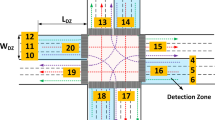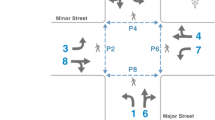Abstract
This paper presents an algorithm for the signal design of an isolated intersection that will be able to alleviate long queues during severe congestion conditions, which cause both lengthy delays and harsh environmental damage. During such periods, the total effective green light is a scarce resource; its best allocation is crucial for the smooth operation of the intersection and sometimes even for a large network. The aim of the procedure presented here is to maximize the average throughput of the intersection. By achieving this goal, the number of vehicles in the queue is reduced at the fastest possible rate, and the period of congestion is shortened. The maximum throughput is achieved when the marginal flow in each phase is equal to the average throughput. The algorithm developed takes into account the decreasing flow rates of existing queues during long periods of green.





Similar content being viewed by others
References
Allsop RE (1971). Delay minimizing settings for fixed time traffic signals at a single road intersection. J Inst Math Appl 8: 164–185.
Ceder A and Reshetnik I (2001). An algorithm to minimize queues at signalized intersections. J Opl Res Soc 52: 615–622.
Chang TH and Lin JT (2000). Optimal signal timing for an oversaturated intersection. J of Trans Res 34B: 471–491.
El-Reedy I and Ashworth R (1978). Platoon dispersion along a major road in Sheffield. TEC 19: 186–189.
Gazis DC and Potts RB (1963). The oversaturated intersection. In: Proceedings of the Second International Symposium of Theory of Traffic Flow. Organization for Economic Cooperation and Development, Paris, pp 221–237.
Gill PE et al (1981). Practical Optimization. Academic Press: New York.
HCM (1994). Highway Capacity Manual Special Report 209, third edn. Transportation Research Board: Washington, DC.
Honglong L and Prevedouros PD (2002). Detailed observations of saturation headways and start-up lost times. Trans Res Record 1802: 44–53.
Japs B (1999). The MOVA system of traffic control and signaled junctions—experience in Edinburgh. TEC 40: 314–316.
Kell JH and Fullerton IJ (1991). Manual of Traffic Signal Design, second edn. Prentice Hall: Englewood Cliffs.
Lin LT et al (1993). A platoon dispersion concept for critical block length for coordinated traffic signal design. In: Compendium of Technical Papers. Institute of Transportation Engineers, pp 478–482.
Mahalel D, Gur Y and Shiftan Y (1991). Manual versus automatic operation of traffic signals. Trans Res 25A: 121–127.
May AD and Montgomery FO (1986). Avoiding the need for manual intervention in signal control: a case study in Bangkok. In: Proceedings of the Second Internal Conference on Road Traffic Control. Institution of Electrical Engineers, pp 85–90.
Michalopoulos PG and Stephanopoulos G (1978). Optimal control of oversaturated intersections: theoretical and practical considerations. Traffic Engineering and Control 19: 216–222.
Michalopoulos PG, Stephanopoulos G and Stephanopoulos G (1981). An application of shock wave theory to traffic signal control. Trans Res 15B: 35–51.
Miller AJ (1963). Settings for fixed-cycle traffic signals. Opl Res Quarterly 14: 373–386.
MOVA (1988). Traffic Responsive, Self-optimizing Signal Control for Isolated Intersections. TRRL Research Report 170: Crowthorne.
Ortega JM (1987). Matrix Theory. Plenum Press: New York.
Pignataro LJ et al (1978). Traffic Control in Oversaturated Street Networks. NCHRPR 194. TRB: Washington, DC.
Pline JL (ed) (1999). Traffic Engineering Handbook. Institute of Transportation Engineers: Washington, DC.
Smith MJ (1988). Optimum network control using traffic signals. In: Proceedings of the Colloquium on UK Developments in Road Traffic Signaling. Institution of Electrical Engineers: London, pp 8/1–8/3.
TRANSYT-7F (1987). User's Manual, Release 5.0. Federal Highway Administration: Washington, DC.
Webster FV (1958). Traffic Signals Settings. Road Research Technical Paper No. 39, HMSO, London.
Acknowledgements
The paper was written while D Mahalel was an Honorary Visiting Academic at Middlesex University, London. We thank Professor CC Wright for his valuable discussions on this study.
Author information
Authors and Affiliations
Corresponding author
Appendix: Validation of the basic algorithm
Appendix: Validation of the basic algorithm
Definitions:
γ m (t), m=1, … M are continuous positive functions.
Ψ(•) is the same function as defined in Equation (2) above, namely:  when ḡ0=(g1, g2, …, g
M
)T is a vector all whose components are positive; and for each of them, the function γ
m
(t) is non-increasing for t⩾g
m
.
when ḡ0=(g1, g2, …, g
M
)T is a vector all whose components are positive; and for each of them, the function γ
m
(t) is non-increasing for t⩾g
m
.
For convenience, denote

Thus

Proposition 1
-
Let γ m (t) be non-increasing in the interval [a, a+b]; then the following inequalities hold:

Proof
-
Trivial.
Proposition 2
-
Let γ m (t) be non-increasing in the interval [a, a+b]; then the following inequalities hold:

Proof
-
Perform some algebraic manipulations to obtain:

This inequality is correct because, according to proposition 1, the following inequalities hold:

and

The quotient of these two expressions gives Equation 12 above.
Proposition 3
-
Let γ1(t) and γ2(t) be two continuous positive non-increasing functions, and let ḡ0=(g1, g2, …, g M )T be a vector for which γ1(g1)>γ1(g2)>Ψ(ḡ0). Then, for any ɛ>0, a 0<δ⩽ɛ exists that satisfies the inequalities Ψ(ḡ1)>Ψ(ḡ2)>Ψ(ḡ0), where ḡ1=(g1+δ, g2, …, g M )T and ḡ2=(g1, g2+δ, …, g M )T.
Proof
-
The continuation of functions γ1(t), γ2(t), and Ψ(•) leads to the following results:
-
a)
For γ1(g1)>γ2(g2), there is a δ1⩽ɛ that satisfies γ1(g1+δ1)>γ2(g2).
-
b)
For γ2(g2)>Ψ(ḡ0), there is a δ2⩽ɛ that satisfies γ2(g2+δ2)>Ψ(ḡ0).
Define δ=Min(δ1, δ2).
Following Equation (9), we obtain the following:

and

After some algebraic manipulations, this obtains

According to inequality (10) and result (a) above, the following inequalities hold:


And according to proposition 1 and result (b) above, the following inequality holds:

Completing the required proof. □
-
a)
Proposition 4
-
Let ḡ0 and ḡ1 be two vectors: ḡ0= (g1, g2, …, g M )T and ḡ1=(g1, Δt, g2, …, g M )T (Δt>0).
If Ψ(ḡ0)⩾Ψ(ḡ1) is true, then Ψ(ḡ0)⩾Ψ(ḡ2) is also true for any ḡ2=(g1, Δt+ɛ, g2, …, g M )T, where ɛ>0.
Proof
-
Assign the value of Ψ(ḡ0) to obtain

After algebraic manipulations, we obtain

The denominator is positive, thus the numerator is non-negative. Furthermore, according to proposition 1

If we now check the inequality that has to be proved:

This expression is non-negative because the denominator is positive; the first addends in the numerator are non-negative as shown above.
Proposition 5
-
Let ḡ0 and ḡ1 be two vectors: ḡ0= (g1, g2, …, g M )T and ḡ1=(g1+Δt, g2, …, g M )T (Δt>0).
If Ψ(ḡ0)⩽Ψ(ḡ1)⩽γ1(g1+Δt) is true, then Ψ(ḡ2)⩽Ψ(ḡ1) is also true for any ḡ2=(g1+αΔt, g2, …, g M )T, where 0<α<1.
Proof
-
The expressions for Ψ(ḡ1) and Ψ(ḡ2) can be written as follows:


‘A’ can be isolated in Equation 24 and assigned in Equation 25 to yield

From inequality (10) and the given condition, the following is obtained:
 and γ1(g1+Δt)⩾Ψ(ḡ1), respectively.
and γ1(g1+Δt)⩾Ψ(ḡ1), respectively.These inequalities are assigned in Equation (26) to produce

After algebraic manipulation, the required result is proved:

Proposition 6
-
Let ḡ0=(g1, g2, …, g M )T be the best point that can be reached when using the Greedy search algorithm. Let ḡ1=(g1+ν1, g2, …, g M )T and ḡ2=(g1, g2−ν2, …, g M )T (ν i <g i , i=1, 2).
Then:
-
a)
Ψ(ḡ0)>Ψ(ḡ1);
-
b)
Ψ(ḡ0)>Ψ(ḡ2);
-
c)
Ψ(ḡ0)>Ψ(ḡ4), where ḡ4=(g1+ν1, g2−ν2, …, g M )T.
-
a)
Proof
-
Results (a) and (b) are direct conclusions from proposition 3 and from propositions 4 and 5, respectively.
As for result (c), the following should be proved:

Obviously, the denominator is positive. The numerator is non-negative, since it can be shown from results (a) and (b) that:

Rights and permissions
About this article
Cite this article
Talmor, I., Mahalel, D. Signal design for an isolated intersection during congestion. J Oper Res Soc 58, 454–466 (2007). https://doi.org/10.1057/palgrave.jors.2602146
Received:
Accepted:
Published:
Issue Date:
DOI: https://doi.org/10.1057/palgrave.jors.2602146























 and γ1(g1+Δt)⩾Ψ(ḡ1), respectively.
and γ1(g1+Δt)⩾Ψ(ḡ1), respectively.


